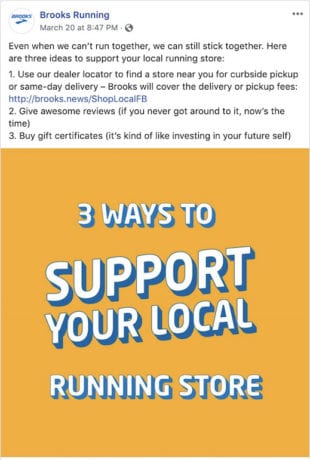What Nonprofits Taught Me About Social Media Marketing

It’s no surprise that the coronavirus has caused either a spike or downfall for companies and marketers across the world. Times are scary for sure, not just from a global, economic and healthcare standpoint but as a marketer, it’s hard to know when and what to share. The news is overwhelming and you might even question if it’s okay to continue marketing when people and the economy are hurting. While sales will likely suffer (unless you’re lucky enough to be selling toilet paper, hand sanitizer or face masks), times like this can present an opportunity to increase brand awareness and present your company as one that strives to come alongside people during crisis. Increased brand awareness and building a customer base that knows and trusts you can result in loyal customers during and post pandemic.
I was sitting through a client call the other day brainstorming social strategies for an ecommerce business and realized a lot of their strategy was similar to what I learned in my previous career as a nonprofit professional. I worked in the nonprofit sector for 5 years prior to entering the digital marketing world and a lot of our marketing strategy was based off emotional appeal. This is because service-oriented nonprofits support people during times of struggle. People, specifically donors, enjoy the feeling of being able to make a difference. Successfully figuring out how to reach out to donors is one of the many duties of a nonprofit marketer. Little did I know the skills I learned in the nonprofit world would be relevant to digital marketers during trying times.
Here are some ways to put a positive spin on your ecommerce marketing techniques during these times of uncertainty. I’ve pulled some ads from my favorite brands to share how businesses are utilizing these techniques during times of crisis!
1) Be Sympathetic – Most people don’t appreciate the person who cracks inappropriate jokes at the wrong time at the big family reunion. Don’t be that person. Don’t market images or services that go against social distancing or other protocols in place (Seriously, it will likely be disapproved anyways). Instead, consider messaging that supports your customers in a time of need. Brooks Running even encouraged their customers to support local running stores. This depicts that they’re a company who cares about more than just profit.

2) Do Research On Your Industry- What are some trends, positive or negative within your industry? Be sure to utilize knowledge and data already present. No need to reinvent the wheel entirely!
3) Use Lighthearted Humor – While I absolutely don’t deny the severity of the current crisis, sometimes a bit of tasteful, light-hearted humor can score a win with your customers. Are you a fashion company? Perhaps poke fun at all the remote workers wearing sweatpants all day when working remotely. Are you a grocery delivery service? Then advertise being able to get groceries delivered without walking away from your refrigerator. Get creative with brainstorming fun ways to engage with your customers! Here, Barry’s Bootcamp is poking fun at the fact you don’t even need to change your wardrobe to workout.

4) Interact With Your Customers – Intentionally interacting with your customers shows you care. While several businesses are likely too large to maintain this type of contact with customers, any kind of interaction with customers can be viewed positively! Comment on social media posts if possible and even feel free to go live with stories on Facebook or Instagram. If you’re selling products online, be sure to have stellar customer service or chat commerce. Internet usage is up, especially during times of social distancing so be sure to take advantage of this opportunity. Here, Kodiak Cakes is asking their followers what they eat for breakfast. This is a fun way to get to know your customers and engage with them on social media.

5) Giveaways & Stories – Who doesn’t like free stuff? Can your business afford to do giveaways in return for customers retweeting, commenting or sharing your posts? Not only will this result in a happy customer but it can also make brand awareness skyrocket. Can you offer free delivery for online orders with limited access to stores? Do you have positive testimonials of customers who love your product? Don’t be afraid to share that on social media. People will love it. Here, Nature’s Bakery is having a drawing for a month’s worth of snacks and a water bottle if people follow them and tag a friend.

6) Have A Clear Call To Action – This is probably one of the most important things to remember as a marketer. What do you want your customer to do? Don’t forget to include this in your messaging! One of the biggest mistakes you can make is successfully increasing brand awareness without prompting your customers to take action. Be sure to have clear, measurable KPIs and conversion actions in mind. Here, Mrs. Myers is telling customers to purchase their new scent for their cleaning products.

Wrapping it Up…
In the nonprofit marketing world, it is best practice to split your content evenly into three areas – Appreciation, Advocacy & Appeals. While there are obvious disparities between nonprofits and businesses, not every post has to promote your product or service. It’s okay to add variety in moderation. Sometimes we need to courageously take a few steps back in order to move forward in the future. Below, you can see Starbucks sharing a story about one of their partners (employees) going above and beyond to serve a customer. Note how they don’t use every post to prompt customers to purchase but they also use posts as an opportunity to share stories.

People will remember your business for treating them with kindness during these times and this will likely result in returning or new customers. Be sure to have fun with your marketing! While businesses and nonprofits have their differences, I think there are a few practices from the nonprofit sector that businesses can learn from during trying times!


















